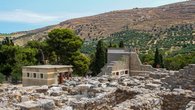
A long-lasting debate is whether ubiquitous Holocene changes in the Mediterranean vegetation, erosion and sedimentation are linked to climate change or anthropogenic impact (e.g. Fuchs, 2007). Crete, Greece is home to the Minoans, Europe's earliest advanced civilization, dominating the island from the 36th to 11th centuries BC. Crete is also famous for its outstanding archaeological and historical record of the Minoan, Hellenistic, Roman, Byzantine, Venetian, Arab to modern civilizations. Much is known about the culture, history, and agriculture of these different civilizations; however little data exists on their impact on the Cretan landscape. For example, intensive agriculture of crops and livestock along with extensive deforestation are known to have supported an advanced hierarchical Minoan society, yet little work has focused on the response of geomorphic systems to this anthropogenic forcing. It has even been suggested that the rapid decline of the Minoan civilization may be linked to excessive deforestation and landscape change. To mitigate problems of soil erosion it is important to understand the drivers of Mediterranean landscape change, and especially data are required to identify, which landscape changes are reversible and when points of no return are being crossed.
Dr. Richard Ott is quantifying changes in erosion rates on different time-scales from river sediments by measuring cosmogenic radionuclides. This technique will hopefully elucidate, if and by how much humans have changed erosion rates on Crete and, whether the Minoans have contributed to their own demise by deforestation.
For more information visit the website: https://richardott.weebly.com/

